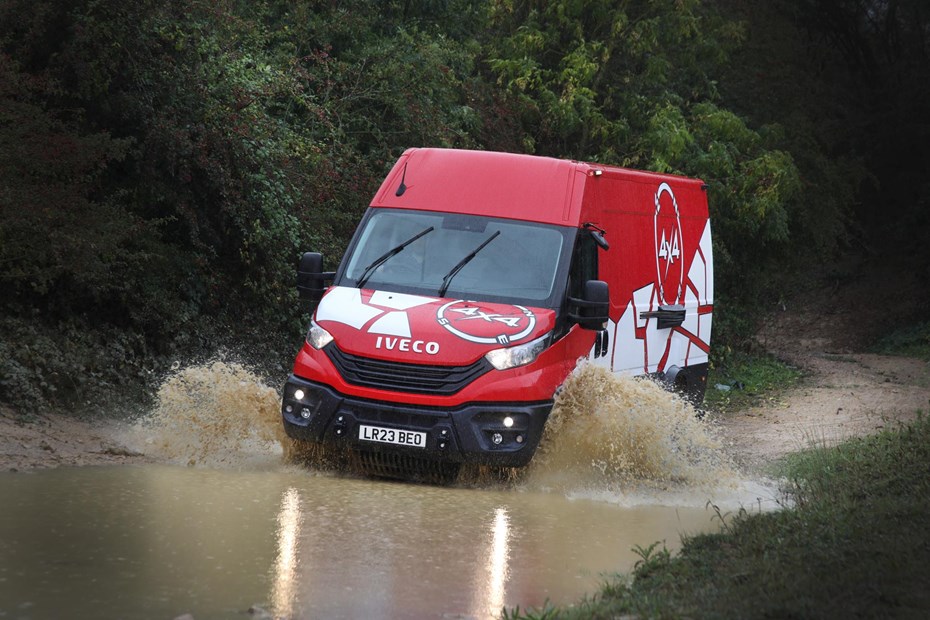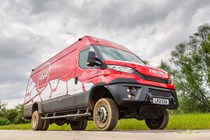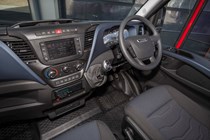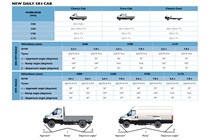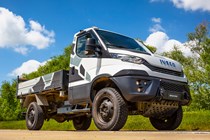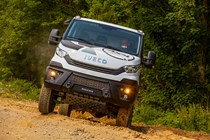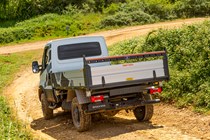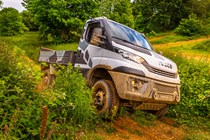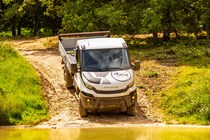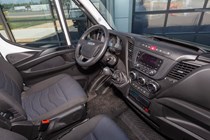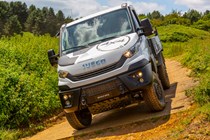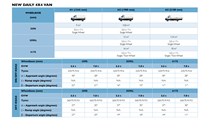Plenty of commercial 4x4s will go off road over some really demanding terrain, and many large vans will carry loads of stuff. Rarely will a van do both. This is where the Iveco Daily 4×4 is looking to step in.
Sure, several large vans come with a 4×4 version, but many, like the Mercedes-Benz Sprinter 4×4 or the Volkswagen Crafter 4Motion come with a few light upgrades compared to the Daily.
Before we go any further, it is worth explaining why we are dealing with the Daily 4×4 separately and not treating it as part of the main review. That’s because you can only get the off-roading version with a 5.5 or 7.0-tonne gross vehicle weight. This means you won’t be able to drive it on public roads if you passed your test after 1 January 1997 and never upgraded it from the Category B licence that was standard issue from that date forward. If all your work is on private land, as our test drives were, then this matters not.
In fact, this heavier setup makes the Daily 4×4 make more sense in some ways. All the things about the Daily that make it sometimes tricky to recommend as a 3.5-tonne van come to the fore in tougher environments away from regular roads. And the result is set of vehicles available in a wide range of variants that can do a job very few other easily operated commercial vehicles can do.
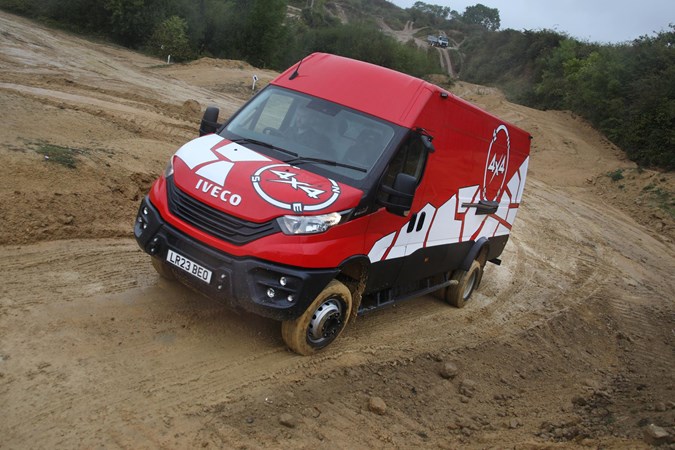
They aren’t as extreme as the ultimate off-roading truck, the Unimog but they are significantly cheaper. And even though that still makes them expensive compared with a conventional van or chassis cab, you get a whole lot of capability in return.
We’ve tried out the updated Iveco Daily at a dedicated quarry on a course designed to test vehicle and driver.
What’s the difference between the Iveco Daily 4×4 All-Road and Off-Road variants?
There are, slightly confusingly, two versions of Iveco Daily 4×4 – the All Road and Off Road. The All-Road – also referred to as the On/Off Road Iveco Daily 4×4 – is engineered to be used on, well, all surfaces. It has the lifted suspension and fully lockable four-wheel-drive system necessary to head off the tarmac but is fitted with twin rear wheels and is designed to be the palatable for long stints on the motorway if needs be.
The Off-Road version gets a taller wheel and tyre combo, and comes with single rear wheels and a slightly different differential arrangement. This is intended to be used almost exclusively off-road – it is still road legal, but less enjoyable to drive on ordinary tarmac.
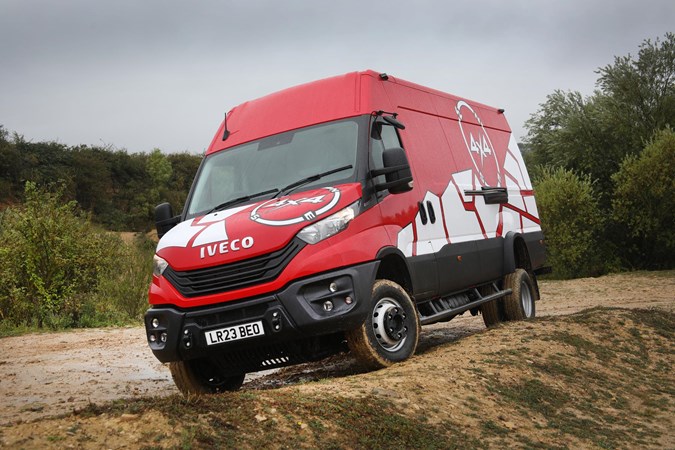
Both feature a specially uprated chassis frame, three-piece steel front bumper, three differential locks – front, centre and rear, activated independently – and a low range setting for the gearbox, selected via a button with a tortoise on it.
Six-speed manual and Hi-Matic eight-speed automatic transmissions are available. We’ve only sampled the latter in the very latest versions of the Daily 4×4, but can vouch for it being the nicer option on road.
The engine is a 3.0-litre diesel with 190hp and 430Nm of torque. Because this is such a hefty van, this meets the latest Heavy Duty Euro VI emissions requirements, rather than the LCV Euro 6 equivalent.
Is the Iveco Daily 4×4 any good off road?
It most certainly is, though for the target market, this clear capability is probably secondary to Daily’s fundamental strength.
The off-road terrain we were faced with in the Daily were demanding, but not overtly so. It was wearing road-biased tyres but still managed to climb and descend some fairly steep slopes on loose surfaces in the rain. We stopped short of tackling the sort of really testing tracks that you would hope to get over in a more purpose-built 4×4, though – the likes of the Land Rover Defender Hard Top or a pickup truck are still your best bet if that is what you want/need to deal with.
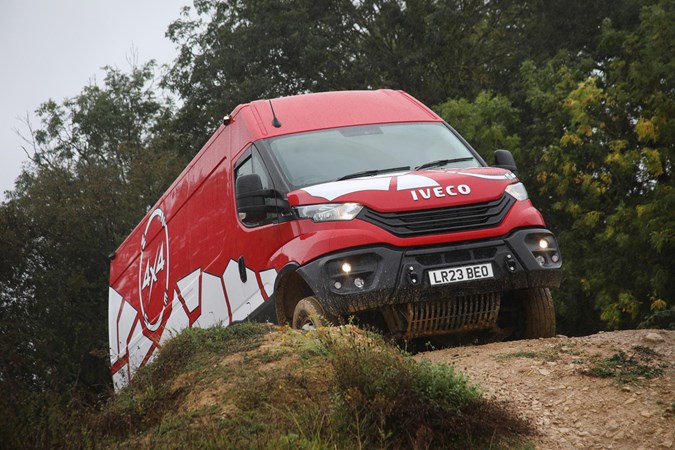
One factor that is really in the Daily 4×4’s favour is its three locking differentials – one for the front, one at the rear and a central one. The issue we had was the the instructor beside us was merrily pressing away at them while we went around the course, so there was never a point where we learned what happens if you leave them off. The setup is all very manual, and those who are not seasoned off-roaders might have to learn the best approach through trial and error.
These differentials and the increased ride height and underfloor protection means the Daily 4×4 certainly has the kit to go further than its 4×4 rivals.
But the larger point is that thanks to the Daily’s truck-style separate chassis – now unique among large vans – the 4×4 versions can do all this in combination with a gross vehicle weight (GVW) of up to 7,000kg (7.0 tonnes).
That is a huge amount more than other large vans, even normal road-going models, and means Daily 4×4 payload is as high as 4,300kg – depending on the variant. This is the heaviest of any heavy-duty vans and smashes the rivals’ capabilities.
They are big, too – as long as 7m in some cases, which means there is a load area in the panel van versions that can be as big as 18.0 cubic metres. The caveat we’ll enter here is that we didn’t get to try the Daily 4×4 with its full multi-tonne payload on board.
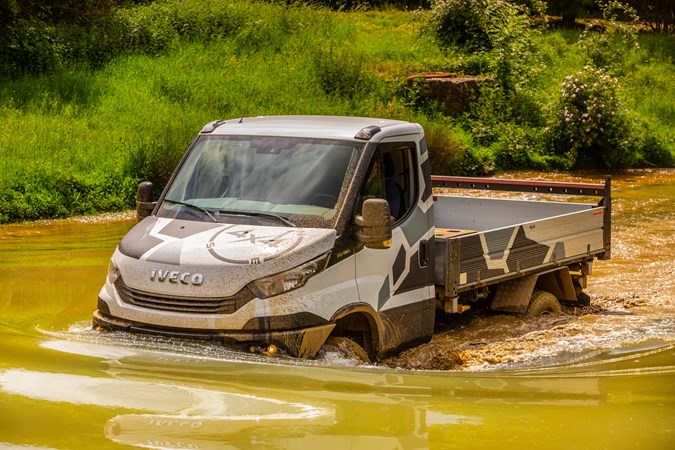
Both versions of the Daily 4×4 are equipped with a wading mode that stops the engine fan to prevent damage. A piercing alarm sounds for the entire time the fan is stopped, just to make sure you don’t forget to switch it back on again and accidentally cook the motor once you’ve finished splashing about.
Tailored factory options for the 4×4 models include bull bars – which can be colour-coded – and provision for a front-mounted winch. Like all Dailys, they’re also available with highly sophisticated connectivity and more.
Are they difficult to drive?
No more so than any other Daily, really – though that’s not to say you can expect to swan about off-piste without taking the time to think about things occasionally.
The panel van we drove is one of the long ones, so over seven metres long, and fitted with a tow hook. This makes it susceptible to grounding-out at the rear over moderate bumps. The optional eight-speed auto takes plenty of the stress out , as it handles the gearing for you very smartly and even provides some engine-braking on steep descents. There’s no dedicated hill-descent mode, though, so you are best off being ready to apply some wheel brake via the pedal as the tyres could well lose grip eventually, especially if you are maxing out the payload.
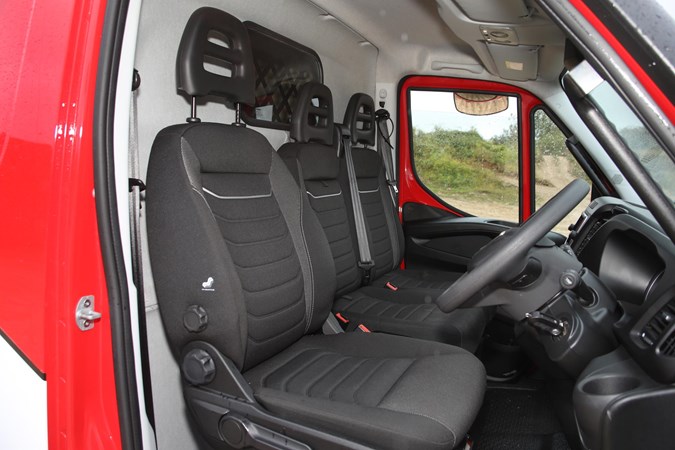
Activating all the toys is very straightforward – the low-range gearbox setting is much quicker to engage here than we’ve experienced in many pickups, for example.
We’ve yet to sample the Daily 4×4 on the road on account of that pesky category B licence, but can certainly understand how the All-Road is the better choice if lengthy tarmac journeys are also part of your remit.
Do you need a special licence?
The maximum gross vehicle weight allowed by a regular UK car driving licence is 3,500kg (3.5 tonnes). So to drive the heaviest versions of the Daily 4×4 – and the panel van isn’t even available as a 3.5t model – you’ll need what’s called a Category C1 licence.
If you passed your driving test before 1 January 1997, you’ll have been granted one of these automatically. But if you passed after that date you’ll need to get one – which involves a provisional application plus theory and practical tests.
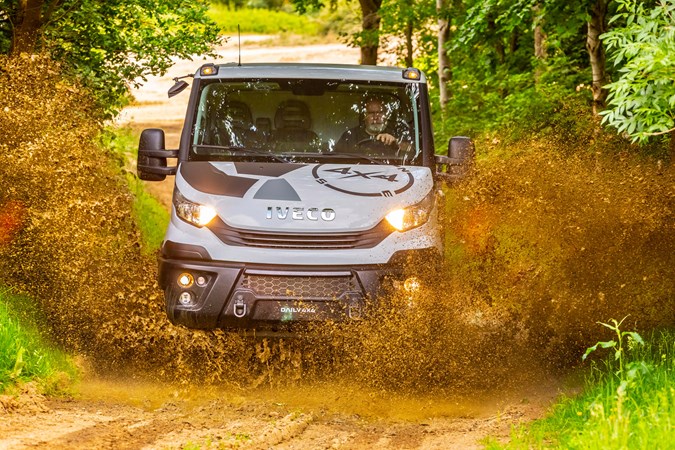
This only matters if you’re driving on-road. If it’s just off-road work then the licencing issue doesn’t really apply.
Who are the Daily 4x4s aimed at?
Mostly heavy-duty operators who need to carry a lot of kit – be that in volume or in weight – into areas that an ordinary large van can’t reach. Examples would be utility firms, some forms of agriculture and emergency services.
However, they are also bought by retail customers, including lifestyle buyers looking to create super-tough, go-anywhere, campervans and motorhomes.
How much does the Iveco Daily 4×4 cost?
Getting precise pricing out of Iveco is always a challenge – as the dealers generally deal with companies rather than individuals, there isn’t a straightforward pricelist to peruse.
To get exact pricing on the variant that meets your requirements, you’re best speaking to your local Iveco dealer, but to give you an idea, the pre-update All-Road panel van weighs-in at around £80,000, while the (smaller) Off-Road chassis cab is worth around £75,000. Both are 7,200kg GVW variants.
For context, a new Unimog is going to be into six figures, and doesn’t come with a Daily-sized load area…



